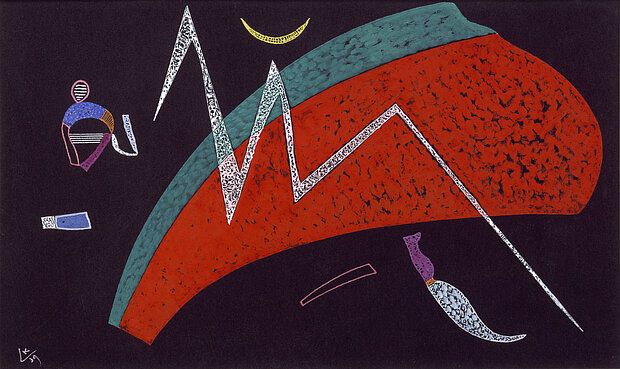
Kandinsky, Wassily
L‘Elan tranquille
Quiet Impulse
1939

© mumok
| Object description | Gouache on paper |
|---|---|
| Object category | painting |
| Material |
object:
gouache
Support:
paper
|
| Technique |
object:
gouache
|
| Dimensions |
object size with backing card:
height: 41,9 cm,
width: 61,8 cm,
depth: 0,15 cm
object:
weight: 3 kg
object size without backing card:
height: 30 cm,
width: 49,8 cm
frame dimension:
height: 81 cm,
width: 60,5 cm,
depth: 2,5 cm
|
| Year of acquisition | 1961 |
| Inventory number | B 35/0 |
| Creditline | mumok - Museum moderner Kunst Stiftung Ludwig Wien |
| Rights reference | Gemeinfrei | public domain |
| Further information about the person | Kandinsky, Wassily [GND] |
| Literature |
China Welcomes You......Sehnsüchte, Kämpfe, neue Identitäten ahoi herbert! bayer und die moderne Kandinsky, watercolours and other works on paper : [on the occasion of the exhibition Kandinsky: Watercolours and other Works on Paper, Royal Academy of Arts, London, 14 April - 4 July 1999] |
The Russian graphic artist, painter, and art theorist Wassily Kandinsky completed his work “L´Elan tranquille” in 1939. Kandinsky was living in a Paris suburb at the time, far away from the international art scene. He had left Germany after the Dessau Bauhaus was closed in 1933. While he was working on this painting, Adolf Hitler was beginning his war that would devastate the whole of Europe. During his eleven Paris years up to his death in 1944, Kandinsky returned to working intensely on his painting. In “L´Elan tranquille” he did not paint objects that we can recognize or clearly name. The actually indicates a remote movement. In the center of the picture there is a floating red and green bow before a black background, with a jagged bright diagonal line painted over it. Smaller suspended shapes seem to keep the composition in balance. Colors and shapes are independent expressive elements. The colored surfaces and lines seem to thrust forward and then back again into the dark background. This leads to a vibrating three-dimensional effect. Wassily Kandinsky published several works of art theory in which he very precisely explained his own principles of composition. He formulated a kind of grammar of his own abstract painting, allocating colors and shapes of symbolic significance. This system was influenced by Kandinsky’s own innate synaesthetic perception, in which the different sensory impressions of sound, shape, or color are all interconnected. For Kandinsky this was a natural feature of his art, where a light blue corresponds to a flute or a dark blue a cello, for example. Kandinsky noted: “The horizontal line is a cold supporting base, silent and ‘black.’ The vertical line is active, warm, ‘white.’ Free straight lines are mobile, ‘blue’ and ‘yellow.’ The surface itself is heavy at the bottom and light at the top, like ‘distance’ on the left and like ‘house’ on the right.’” In Kandinsky’s late work—“L´Elan tranquille” is a later work—the shapes are less strictly geometrical. They are more like amorphous forms and are freer. Kandinsky’s principles of composition thus assume a “calm élan.”
© mumok – museum moderner kunst stiftung ludwig wien